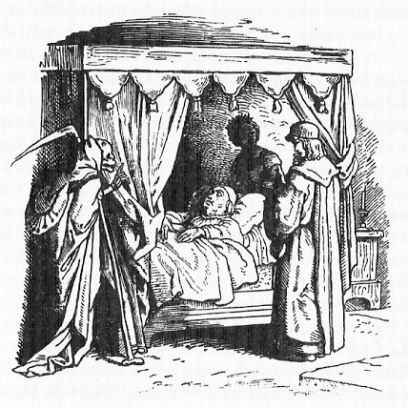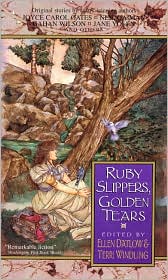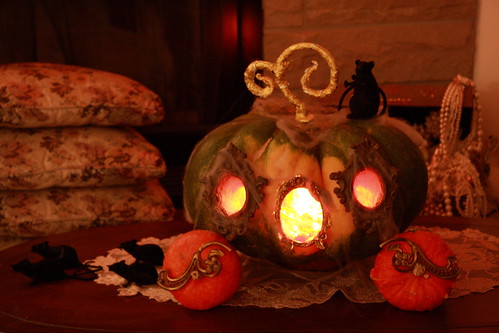Death followed through on his promise and gave his godson a gift-he would become a famous physician with the ability to tell if a patient would survive or not. If Death was standing by the head of the bed of the patient, the physician would be able to cure him with an herb that Death gave him-if Death stood by the foot of the bed, the patient would die. With this advantage, the physician became famous and rich.
But one day the physician was called to look in on the King, who was sick, and when he got there, he saw Death at the foot of the bed. Though he knew he would be risking Death's displeasure, the physician turned the bed so that Death was at the head and administered the healing herb. Death was upset and warned his godson he wouldn't be able to get away with any trickery again.

Ludwig Richter
Not long afterwards, the King's daughter fell ill, and the King proclaimed that if anyone could save her, he should marry her and inherit the crown. The physician was so dazzled by her beauty and the prospect of being a King that he ignored his godfather and turned the bed again, giving her the herb. But this time Death was so furious that he took the physician by the hand and down to a cavern filled with flickering candles of all sizes. Death explained that each human life had a candle, and as soon as the candle flickered out, their life was over. Death showed the physician his candle, which was just about to go out. The physician begged to be allowed to live and marry the princess, but Death could not light a new candle without snuffing out another one. Death pretended he was getting a new candle for his godson, but deliberately put the candle out because he wanted his revenge, and the physician fell down and his life was ended.
This morbid tale taps into two things that all people struggle with at some point, no matter what your faith-the unfairness and cruelty of the world, and the inevitability of death. Naturally it would have been completely controversial in Victorian times to accuse God of being unfair, so the Grimms threw in a little narration to save themselves: "The man said that because he did not know how wisely God distributes wealth and poverty." Even though I'm a Christian, I don't like this little addendum of theirs-it sounds like the rich deserve to be rich and the poor deserve to be poor. And poverty for this man wasn't just that he had to wait a while before getting the newest version of the Iphone-it meant real hunger and deprivation, and watching his children suffer as well.
But I don't see Death as being all that much fairer. Yes, death comes to all, but death comes to some who are young and some who are old, and some suffer in death and some go peacefully. In this tale, even though Death supposedly makes no distinction between wealth and poverty, he gives his godson a gift that allows him to be rich and successful, and has mercy on him after his first offense.

I find it interesting that so many cultures personified Death as a character. Sometimes this is done more humorously, as in Family Guy where Death is just a regular guy doing his job and trying to get a girl. But aside from parodies, stories that feature Death generally all point to the same conclusion-no one can escape or cheat death. The trickery that the physician tries probably would have been rewarded in some fairy tales, but here it proves to be his downfall. And the cavern full of flickering candles is so haunting-it reminds me of one of my favorite Ray Bradbury stories, "The Scythe," where a man is unwillingly made to be, essentially, Death, cutting down stalks of wheat which are each people's lives-and he, like the physician in this tale, discovers that he can't cheat the system or save the lives of people he loves.

Sorry to end on such a downer-hope you all have a magically wicked Halloween weekend!
































